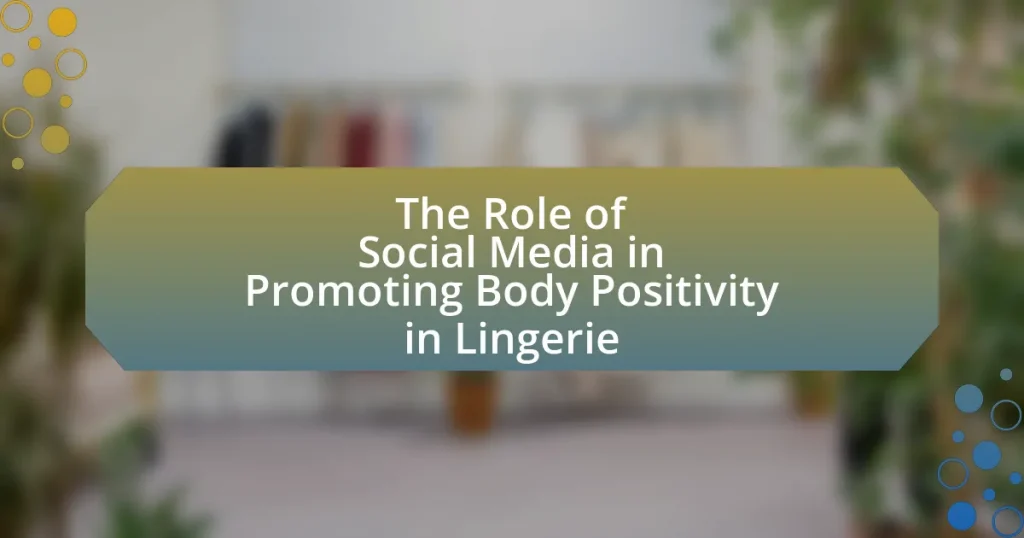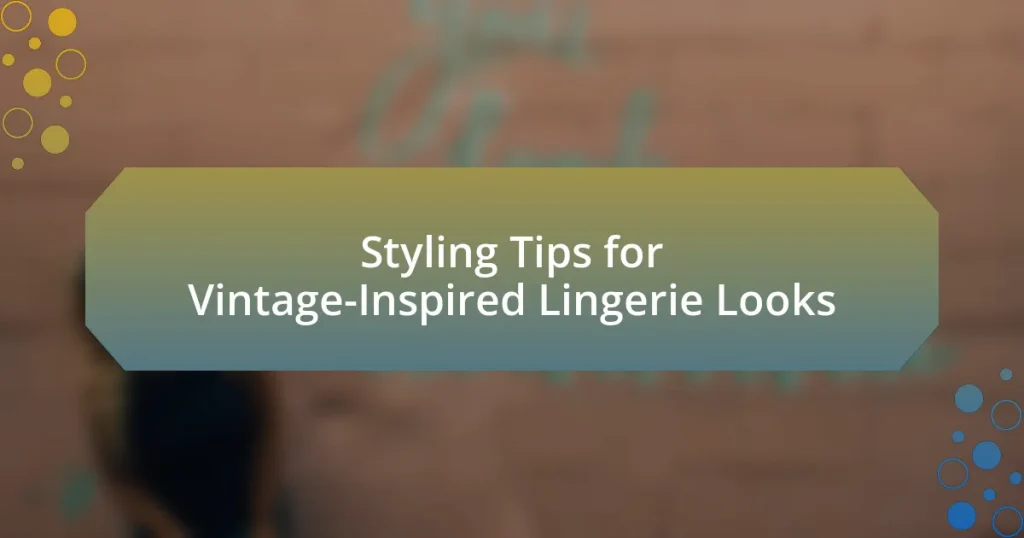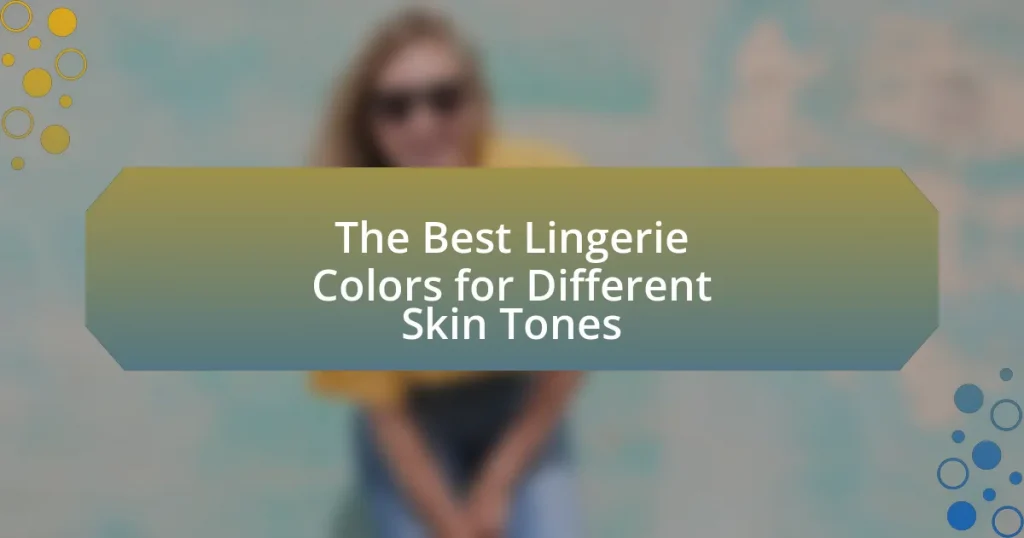The article examines the significant role of social media in promoting body positivity within the lingerie industry. It highlights how platforms like Instagram and TikTok facilitate diverse body representations, challenge traditional beauty standards, and foster community support. Key discussions include the influence of user-generated content and influencers on body image perceptions, the effectiveness of inclusive marketing strategies, and the impact of body positivity on consumer behavior and brand loyalty. Additionally, the article addresses the challenges brands face in promoting body positivity and outlines best practices for successful campaigns.

What is the Role of Social Media in Promoting Body Positivity in Lingerie?
Social media plays a crucial role in promoting body positivity in lingerie by providing a platform for diverse body representations and fostering community support. Through user-generated content, influencers, and brands, social media showcases a wide range of body types, challenging traditional beauty standards and encouraging acceptance. For instance, campaigns like Aerie’s #AerieREAL have successfully increased body positivity by featuring unretouched images of models of various sizes, leading to a reported 20% increase in sales. This demonstrates that social media not only amplifies body diversity but also positively impacts consumer behavior and brand loyalty.
How has social media influenced perceptions of body image in lingerie?
Social media has significantly influenced perceptions of body image in lingerie by promoting diverse representations of body types and challenging traditional beauty standards. Platforms like Instagram and TikTok have enabled brands and influencers to showcase models of various sizes, ethnicities, and shapes, which has contributed to a broader acceptance of different body images. Research indicates that exposure to diverse body types on social media can lead to improved body satisfaction among viewers, as evidenced by a study published in the journal “Body Image” by Tiggermann and Slater, which found that participants exposed to images of diverse body types reported higher body satisfaction compared to those who viewed thin-ideal images. This shift in representation fosters a more inclusive dialogue around body positivity in the lingerie industry.
What platforms are most effective in promoting body positivity in lingerie?
Instagram and TikTok are the most effective platforms in promoting body positivity in lingerie. Instagram’s visual-centric approach allows brands and influencers to showcase diverse body types through images and videos, fostering an inclusive community. TikTok’s short-form video format encourages authentic storytelling and engagement, enabling users to share personal experiences and promote body positivity in a relatable manner. Research indicates that campaigns featuring diverse models on these platforms lead to increased consumer engagement and positive brand perception, highlighting their effectiveness in this social movement.
How do influencers contribute to body positivity in the lingerie industry?
Influencers contribute to body positivity in the lingerie industry by showcasing diverse body types and promoting self-acceptance through their platforms. They challenge traditional beauty standards by featuring models of various sizes, shapes, and ethnicities, which helps to normalize different body representations. For instance, campaigns by influencers often highlight the importance of comfort and confidence in lingerie choices, encouraging their followers to embrace their bodies as they are. This approach is supported by research indicating that exposure to diverse body images can improve body satisfaction among viewers, as noted in a study published in the journal “Body Image” by Tiggermann and Slater, which found that media representation significantly impacts self-esteem and body image perceptions.
Why is body positivity important in the lingerie market?
Body positivity is important in the lingerie market because it promotes inclusivity and acceptance of diverse body types, which can enhance consumer confidence and satisfaction. Research indicates that brands embracing body positivity see increased customer loyalty and engagement; for instance, a study by the American Psychological Association found that positive body image correlates with higher self-esteem and better mental health outcomes. By representing a wide range of body shapes and sizes, lingerie brands can challenge traditional beauty standards and foster a more supportive shopping environment, ultimately driving sales and brand reputation.
What impact does body positivity have on consumer behavior?
Body positivity significantly influences consumer behavior by encouraging individuals to embrace diverse body types, leading to increased purchasing of inclusive and body-positive brands. Research indicates that consumers are more likely to support brands that promote body diversity, with a study by the University of Kent showing that 67% of participants preferred brands that featured models of various sizes. This shift in consumer preference drives companies to adopt more inclusive marketing strategies, ultimately affecting sales and brand loyalty.
How does body positivity challenge traditional beauty standards in lingerie?
Body positivity challenges traditional beauty standards in lingerie by promoting inclusivity and diversity in body shapes and sizes. This movement encourages brands to feature models of various body types, which contrasts with the historical norm of using predominantly thin models. Research indicates that 67% of women feel more confident when they see diverse body types represented in advertising, highlighting the impact of body positivity on consumer perception and self-image. By advocating for representation, body positivity shifts the narrative around beauty, making it more accessible and relatable for a broader audience.
What strategies do brands use on social media to promote body positivity?
Brands use inclusive marketing strategies on social media to promote body positivity by showcasing diverse body types in their campaigns. This approach includes featuring models of various sizes, shapes, and ethnicities, which reflects a broader representation of beauty. For instance, brands like Aerie and Savage X Fenty have gained recognition for their commitment to body diversity, often using unretouched images and real customer testimonials to foster authenticity. Research indicates that 67% of consumers feel more positive about brands that promote body diversity, highlighting the effectiveness of these strategies in building brand loyalty and community engagement.
How do campaigns featuring diverse body types affect brand perception?
Campaigns featuring diverse body types positively affect brand perception by enhancing relatability and inclusivity. Research indicates that consumers are more likely to view brands favorably when they see representation that reflects their own body types, leading to increased brand loyalty and trust. A study published in the Journal of Advertising Research found that 67% of participants felt more positively about brands that showcased a variety of body shapes and sizes in their marketing. This shift in perception can result in higher engagement rates and improved sales, as consumers feel a stronger emotional connection to brands that promote body positivity.
What role do user-generated content and testimonials play in promoting body positivity?
User-generated content and testimonials significantly enhance body positivity by providing authentic representations of diverse body types and experiences. This content fosters a sense of community and validation among individuals who may struggle with body image issues, as it showcases real people embracing their bodies. Research indicates that exposure to diverse body representations can lead to improved body satisfaction and reduced body shame. For instance, a study published in the journal “Body Image” found that individuals who engage with body-positive content on social media report higher levels of body appreciation. Thus, user-generated content and testimonials serve as powerful tools in promoting body positivity by normalizing various body shapes and encouraging self-acceptance.
How can social media campaigns effectively engage audiences around body positivity?
Social media campaigns can effectively engage audiences around body positivity by utilizing authentic storytelling and diverse representation. Campaigns that feature real individuals sharing their personal experiences with body image foster a sense of community and relatability, which is crucial for audience engagement. For instance, brands like Aerie have successfully implemented the #AerieREAL campaign, which promotes unretouched photos of models and customers, leading to increased brand loyalty and a 20% sales growth in 2019. Additionally, incorporating user-generated content encourages participation and allows audiences to see themselves reflected in the campaign, further enhancing engagement.
What challenges do brands face in promoting body positivity on social media?
Brands face several challenges in promoting body positivity on social media, primarily due to the prevalence of unrealistic beauty standards and the risk of backlash from consumers. The dominance of edited and curated images on platforms like Instagram creates a contrasting environment where authentic representations of diverse body types struggle to gain visibility. Additionally, brands may encounter criticism for perceived insincerity or tokenism if their campaigns are not backed by genuine commitment to inclusivity. Research indicates that 70% of consumers expect brands to take a stand on social issues, including body positivity, which places pressure on brands to align their messaging with their actual practices. Furthermore, navigating the algorithms of social media platforms can limit the reach of body-positive content, as engagement metrics often favor traditional beauty ideals.
What are the best practices for promoting body positivity in lingerie through social media?
The best practices for promoting body positivity in lingerie through social media include showcasing diverse body types, using inclusive language, and collaborating with body-positive influencers. Showcasing diverse body types ensures representation, as studies indicate that 67% of consumers prefer brands that feature models of various sizes. Using inclusive language fosters a supportive community, encouraging individuals to embrace their bodies. Collaborating with body-positive influencers amplifies authentic voices, as their followers often trust their messages, leading to increased engagement and positive brand perception. These practices collectively contribute to a more inclusive and body-positive narrative in the lingerie industry.
How can brands measure the success of their body positivity campaigns?
Brands can measure the success of their body positivity campaigns through metrics such as engagement rates, sentiment analysis, and sales performance. Engagement rates, including likes, shares, and comments on social media posts, indicate how well the campaign resonates with the audience. Sentiment analysis can be conducted on user-generated content and comments to assess public perception and emotional response to the campaign. Additionally, tracking sales performance before, during, and after the campaign can provide concrete data on its impact on consumer behavior. For instance, a study by the American Psychological Association found that positive body image campaigns can lead to increased brand loyalty and purchasing intent among consumers.
What common pitfalls should brands avoid when promoting body positivity?
Brands should avoid tokenism when promoting body positivity, as it can undermine genuine efforts and alienate the target audience. Tokenism occurs when brands feature diverse body types superficially without a commitment to inclusivity in their overall messaging and practices. For instance, a study by the University of California found that consumers can easily identify when brands are not authentically engaged in body positivity, leading to skepticism and backlash. Additionally, brands should refrain from promoting unrealistic beauty standards under the guise of body positivity, as this can perpetuate the very issues they aim to combat. Research from the American Psychological Association indicates that such contradictions can harm brand credibility and consumer trust. Lastly, brands must avoid neglecting the intersectionality of body positivity, as failing to represent various identities can alienate significant segments of their audience.















